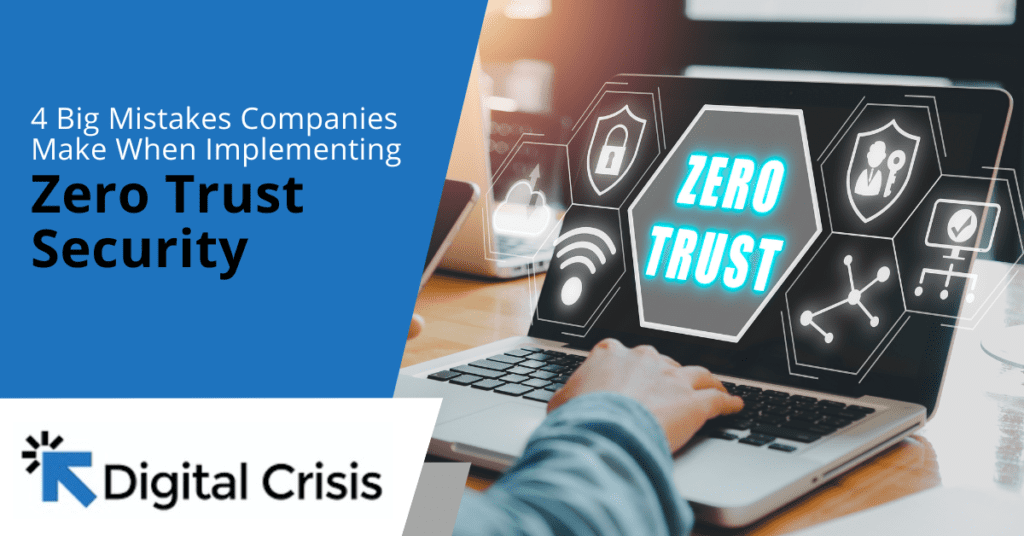
Implementing a Zero Trust security model has become a necessity in today’s digital landscape, where cyber threats loom large and breaches are an all too common occurrence. Zero Trust, a security concept centered around the notion of trusting no one and verifying everything, offers a proactive approach to cybersecurity.
However, despite its effectiveness, many companies make critical errors when implementing Zero Trust strategies. In this article, we delve into the four big mistakes companies make when adopting Zero Trust security measures and explore ways to avoid them.
One of the fundamental mistakes companies make when implementing Zero Trust security is a lack of comprehensive risk assessment. Many organizations fail to thoroughly assess their existing security posture, identify potential vulnerabilities, and understand their data landscape before adopting a Zero Trust model. Without a clear understanding of the risks they face, companies may struggle to design and implement effective security controls.
Conducting a comprehensive risk assessment is essential for developing a robust Zero Trust strategy. It involves evaluating potential threats, vulnerabilities, and the impact of security incidents on the organization’s operations. By identifying assets, mapping data flows, and understanding user behaviors, companies can better prioritize security measures and allocate resources effectively.
To avoid this mistake, companies should invest time and resources in thorough risk assessments before embarking on their Zero Trust journey. This may involve leveraging automated tools for asset discovery and vulnerability scanning, conducting penetration testing, and engaging with security experts to identify blind spots.
Another common mistake in Zero Trust implementation is overlooking the user experience. While prioritizing security is paramount, overly restrictive policies and cumbersome authentication processes can hinder productivity and frustrate employees. This can lead to resistance from users and create loopholes in the security framework as employees seek workarounds.
Achieving a balance between security and usability is crucial for successful Zero Trust adoption. Companies should aim to implement security measures that are transparent to users and seamlessly integrated into their workflows. This may involve adopting multi-factor authentication solutions that are user-friendly, implementing single sign-on capabilities, and providing adequate training and support to employees.
To enhance user experience without compromising security, organizations should solicit feedback from employees and continuously refine their security policies and procedures. By prioritizing simplicity, accessibility, and convenience, companies can encourage compliance and foster a culture of security awareness among users.
A critical mistake many companies make when implementing Zero Trust is neglecting privileged access management. Privileged accounts, which have elevated permissions and access to sensitive systems and data, represent lucrative targets for attackers. Failing to implement robust controls around privileged access can leave organizations vulnerable to insider threats and external attacks.
Effective privileged access management is essential for minimizing the risk of unauthorized access and privilege escalation. It involves implementing stringent access controls, regularly reviewing and revoking unnecessary privileges, and monitoring privileged user activity for suspicious behavior.
To avoid this mistake, companies should implement a comprehensive privileged access management framework as part of their Zero Trust strategy. This may include implementing role-based access controls, enforcing the principle of least privilege, and leveraging privileged access management solutions to monitor and audit privileged user activity.
Despite advancements in technology, human error remains one of the biggest cybersecurity threats faced by organizations. Many companies make the mistake of underestimating the human factor when implementing Zero Trust security measures, focusing solely on technological solutions while neglecting the role of employee awareness and behavior.
Investing in security awareness training is essential for mitigating the risk of human error and strengthening the overall security posture. By educating employees about common cyber threats, phishing scams, and best practices for data protection, companies can empower their workforce to become active participants in the organization’s security efforts.
To address the human factor in cybersecurity, companies should foster a culture of security within the organization. This involves promoting a shared responsibility for security across all levels of the workforce, encouraging open communication about security concerns, and recognizing and rewarding security-conscious behavior.
Implementing Zero Trust security is a critical step towards safeguarding against evolving cyber threats and protecting sensitive data. However, to maximize the effectiveness of Zero Trust measures, companies must avoid common pitfalls and adopt a proactive and holistic approach to security.
By conducting comprehensive risk assessments, prioritizing user experience, implementing robust privileged access management controls, and addressing the human factor through security awareness training, organizations can strengthen their security posture and mitigate the risk of data breaches and cyber attacks.
Remember, at Digital Crisis, we understand the importance of Zero Trust security and offer comprehensive solutions to help organizations build resilient defense mechanisms against cyber threats. Contact us today to learn more about how we can support your security initiatives.